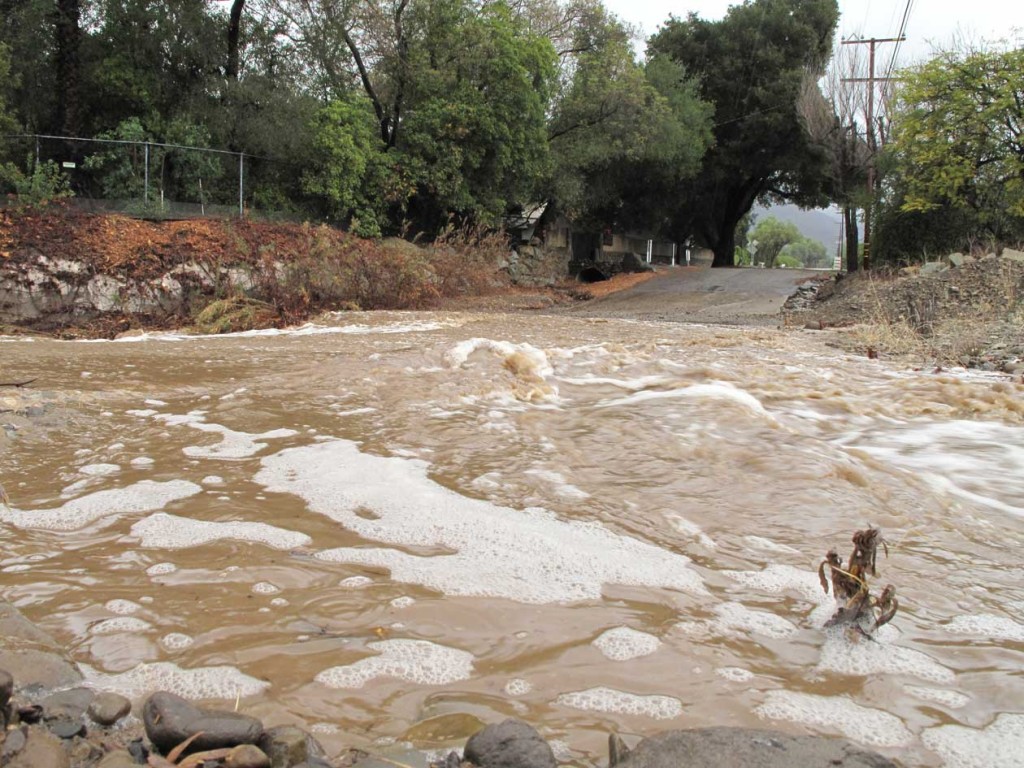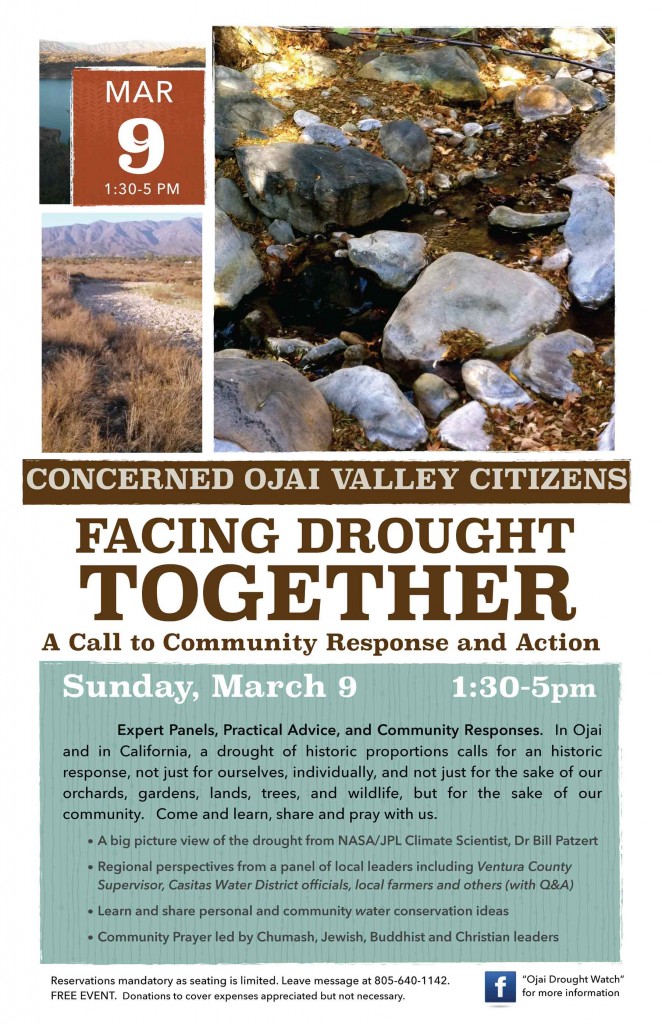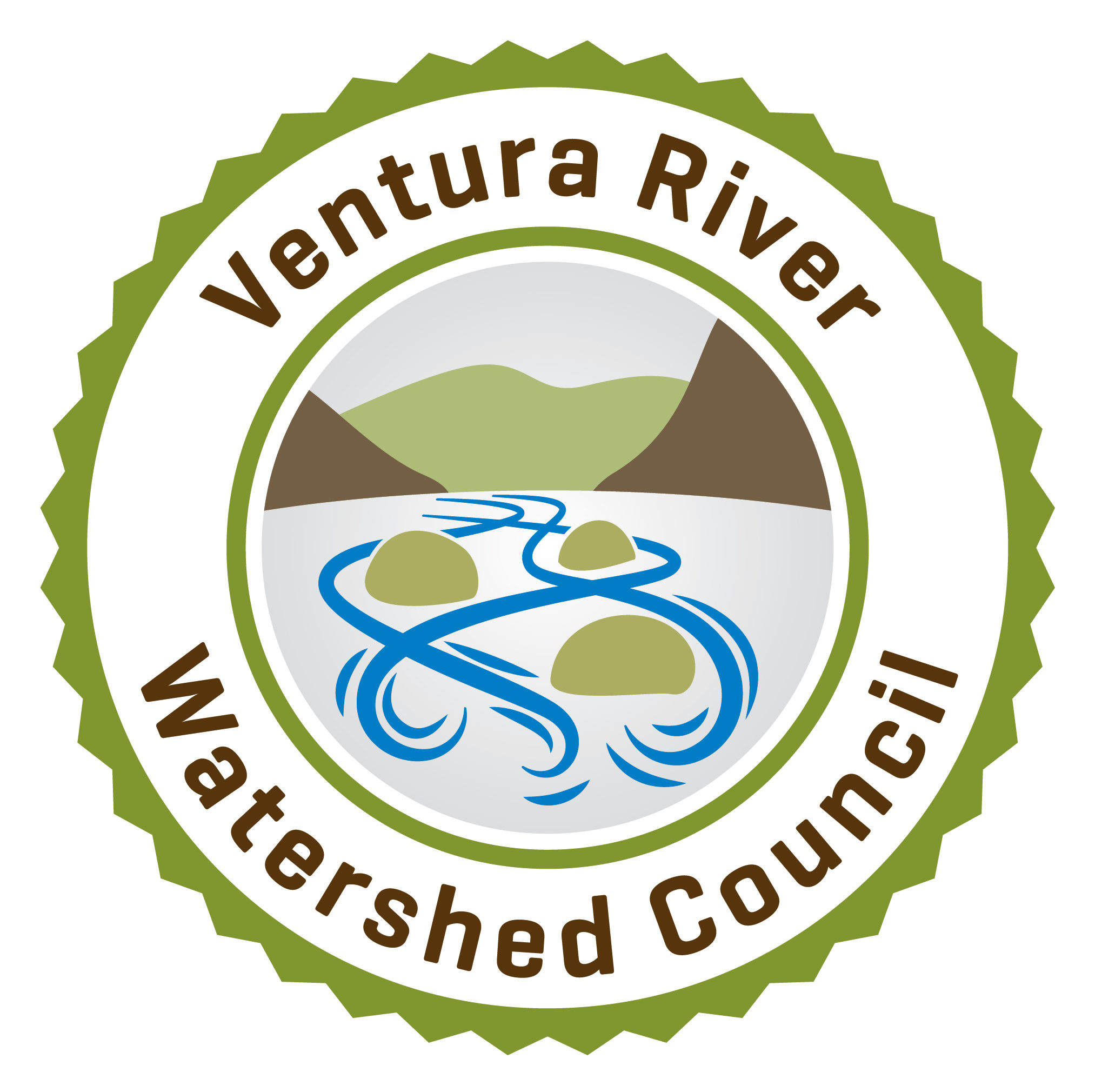River Running
by Steve Sprinkel, writer and Ojai Valley farmer
Reprinted from “Forager,” Steve’s CSA (community supported agriculture) newsletter.
On the Friday when it had rained I went to the coffee shop in the dark. Bobby was there. I told him I was going to run over to the bridge and see if the river was running. Bobby is a water dog. He runs a water company and has to run a back hoe at one AM when the boulders nobody has ever seen shift onto the 18 inch line.
Bobby said “Naw. I don’t think it’s rained enough for that.”
“I gotta go look and see anyway,” I said. Lord Bellwood said he wanted to go too.
We drove over in Olivia’s Euro. I slowed down on the bridge when I saw no one was behind me. I had thought some commuters going to Santa Barbara would rather take the 33 instead of the Pass and dodge some of those boulders. We were safe.
The river had thirty feet of water in it two or three feet deep, churning brown with mud. It was like I had never seen it run. You would never call it beautiful because it was more majestic than that. We rolled down a window because the sound is nearly better than the sight. The river made the sound of a hundred pieces of paper being torn in half in unison, punctuated by a single glurg! every few seconds.
I said to Bellwood: “Now do you want to see the aqueduct?”
“Where?”
“It’s over at the entrance to Casitas. There is a concrete causeway that comes down from the diversion high up on the river. I wonder if it’s running.”
The rain came down a little harder, which was encouraging, as if to say we made the right choice in coming to see the water going into the lake because the sky was opening up good, beating on the roof of the van. A hundred drum sticks drummed the roof and then in five minutes the music blew on up the valley. Fugue in drench.
Eight feet of water three feet deep was rolling down the aqueduct. Twenty four cubic feet a second. 177 gallons a second going into the lake. Forty-four flushes per second. 1400 pint-glasses of water. Sixty-thousand gallons a minute. Two acre feet an hour.
I imagine you always wanted to know what the hell is up with the acre-feet deal. We’ll talk less and less about the acre-feet now that so many of us only care about the quarter acres or the half acre lot for our four bedroom three bath home, hopefully on the deep lot, and on a cul-de-sac, which would be very nice. Quiet out there on the cul-de-sac. Highly recommendable, those. I lived at the end of the road once on one of the world’s longest cul-de-sacs. A dead-end, on two acres that seemed like twenty because most of it was unmanageable. Quiet, but a bit lonely.
Farmers and regulators are the only ones who talk about acre-feet. One reason the acre feet will probably always be cogent is because of the lakes. We may hate them but without them there is no life. Or at least a lot less life for the human. Without a lake you can’t flush or grow strawberries.
But before we go there, you got to know the acre is nearly 44,000 square feet. The acre-foot is water a foot deep covering an acre. Acre-foot. If I was a twenty year old guitarist I would call my band Acre Foot. One way to imagine an acre is something 200 by 200. Excuse me, that’s feet. Or a hundred by four hundred. That’s my favorite, because I have lots of runs four hundred feet long, almost.
The Casitas has a surface area of 2,760 acres and can hold a quarter of a million acre feet. That is the depth times the surface. Three acre feet is a million gallons, which is three hundred thousand flushes. If you flush three times a day, you will flush an acre foot in your lifetime.
You see why the acre-feet is a useful system. You can’t go around talking about that many zeros so you break it down to acre-feet. Once you get the hang of it, the big pro measuring method makes sense. When you were in high school you also wondered why you were expected to grapple with stuff which was to the “power”. Like 103., which is how professionals say 1000. If you want to start talking about how many gallons is in a quarter million acre feet you will have to start bringing in the “power” pretty quick. It’s certainly more useful than light-years, and not so scary.
So, me and Bellwood, who was still there in the Euro watching the torrent shoot down the aqueduct at us, figured there was maybe fifty acre feet a day going into the lake. Since you need at least a hundred thousand more acre feet in Casitas to feel cozy, you are going to need a lot more gullywashers to catch up that deficit. By my reckoning, about 5 more gullywashers, and probably at least one to the power.
Photos of Flowing Streams
Here is a link to some photos taken during the recent storm on Friday, Feb 28 and Saturday, March 1. I was surprised that with the amount of flow in Thacher Creek and Reeves Creek, there was no flow in Upper San Antonio Creek (at the 150 bridge or Grand Ave.) – at least when I looked. Hopefully that is because the water was finding its way into the groundwater basin.

Reeves Creek at McNell Road, Ojai, 2/28/14.
“Our wells have come up about three feet”
Bert Rapp, general manager with Ventura River County Water District (VRCWD), reported today that they have seen about a three-foot rise in the level of their wells from the recent storm. The VRCWD wells are in the Ventura River bed, just above Highway 150. “We need another 10 feet to turn on our Well #3. And another 20 feet to turn on Well #2 & 4. And only 50 feet to get back to normal,” said Bert. The district has one well that is still pumping.
“Facing Drought Together” Forum

Bill O’Brien, a civil engineer very active in Ventura River watershed work, Victoria Loorz, a paster, Kit Stoltz, a reporter and writer, and Ulrich Brugger, who directs The Ojai Retreat, are putting together a public conversation which they hope will help motivate people of the Ojai Valley to take a serious look at our drought and what we can do about it.
Elected officials, water district officials, scientists, farmers, environmental advocates, community members, and local religious leaders are all on the agenda.
Mar 19-22, Salmonid Restoration Federation Conference, Santa Barbara
At the 2014 Salmonid Restoration Federation Conference, which will be held in Santa Barbara March 19 to 22, 2014, Paul Jenkin of Surfrider Foundation will be leading a Ventura River fieldtrip which will include Surfers Point and the Ventura River estuary, the California Department of Fish and Wildlife steelhead monitoring, the Rice Creek realignment restoration on the Ventura River Preserve, the Robles Diversion and Fish Passage Facility, and Matilija Dam.
Those who are only interested in attending the field trip can register just for that day.
There is also a field trip to the Santa Ynez river (in the mountains behind Santa Barbara) to include discussions of the role of beavers in watershed management and health. The conference will also include an Ocean Friendly Gardens session in Innovative Stormwater and Water Conservation workshop.
